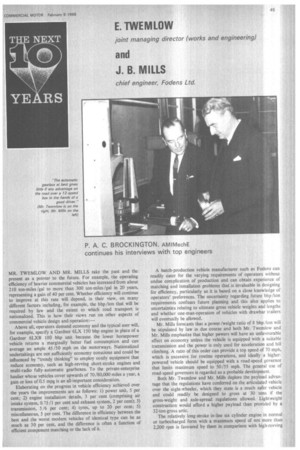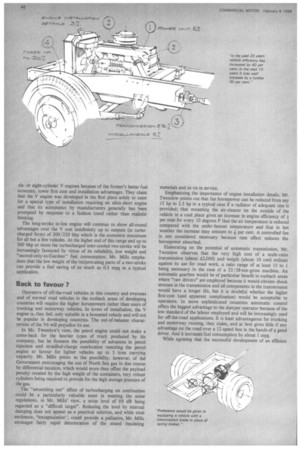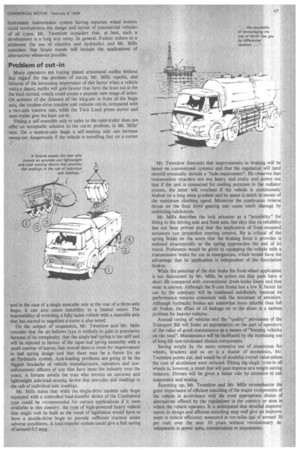E. TINEMLOW
Page 47

Page 48

Page 49

If you've noticed an error in this article please click here to report it so we can fix it.
joint managing director (works and engineering)
and J. B. MILLS
chief engineer, Fodens Ltd.
MR. TWEMLOW AND MR. MILLS take the past and the present as a pointer to the future. For example, the operating efficiency of heavier commercial vehicles has increased from about 210 ton-miles /gal to more than 300 ton-miles /gal in 20 years, representing a gain of 40 per cent. Whether efficiency will continue to improve at this rate will depend, in their view, on many different factors including, for example, the bhp /ton that will be required by law and the extent to which road transport is nationalized. This is how their views run on other aspects of commercial vehicle design and operation:— Above all, operators demand economy and the typical user will, for example, specify a Gardner 6LX 150 bhp engine in place of a Gardner 6LXB 180 bhp unit because the lower horsepower vehicle returns a marginally better fuel consumption and can average an ample 45/50 mph on the motorways. Nationalized undertakings are not sufficiently economy conscious and could be influenced by "trendy thinking" to employ costly equipment that reduce economy, such as high-revving short-stroke engines and multi-radio fully-automatic gearboxes. To the private-enterprise haulier whose vehicles cover upwards of 70/80.000 miles a year, a gain or loss of 0.5 mpg is an all-important consideration.
Elaborating on the progress in vehicle efficiency achieved over the years the improvements are as follows: 1) power unit. 5 per cent; 2) engine installation details, 3 per cent (comprising air intake system, 0.75 /1 per cent and exhaust system, 2 per cent); 3) transmission, 5/6 per cent; 4) tyres. up to 20 per cent; 5) miscellaneous, 5 per cent. The difference in efficiency between the best and the worst modern vehicles of identical type can be as much as 30 per cent, and the difference is often a function of efficient component matching or the lack of it. A batch-production vehicle manufacturer such as Fodens can readily cater for the varying requirements of operators without undue complication of production and can obtain experience of matching and installation problems that is invaluable in designing for efficiency, particularly as it is based on a close knowledge of operators' preferences. The uncertainty regarding future bhp /ton requirements confuses future planning and this also applies to uncertainties relating to ultimate gross vehicle weights and lengths and whether one-man-operation of vehicles with drawbar trailers will eventually be allowed.
Mr. Mills forecasts that a power /weight ratio of 8 bhp/ton will be stipulated by law in due course and both Mr. Twernlow and Mr. Mills emphasize that higher powers will have an unfavourable effect on economy unless the vehicle is equipped with a suitable transmission and the power is only used for acceleration and hill climbing. A ratio of this order can provide a top speed of 70 mph, which is excessive for routine operations, and ideally a higher powered vehicle should be equipped with a road-speed governor that limits maximum speed to 50/55 mph. The general use of road-speed governors is regarded as a probable development.
Both Mr. Twemlow and Mr. Mills deplore the payload advantage that the regulations have conferred on the articulated vehicle over the eight-wheeler, which they state is a much safer vehicle and could readily be designed to gross at 30 tons if the gross-weight and axle-spread regulations allowed. Lightweight construction would afford a higher payload than provided by a 32-ton-gross attic.
The relatively long-stroke in-line six cylinder engine in normal or turbocharged form with a maximum speed of not more than 2,200 rpm is favoured by them in comparison with high-revving sixor eight-cylinder V engines because of the former's better fuel economy, lower first cost and installation advantages. They claim that the V engine was developed in the first place solely to cater for a special type of installation requiring an ultra-short engine and that its acceptance by manufacturers generally has been prompted by response to a fashion trend rather than realistic thinking.
The long-stroke in-line engine will continue to show all-round advantages over the V unit indefinitely up to outputs (in turbocharged form) of 200/220 bhp which is the economic maximum for all but a few vehicles. At the higher end of this range and up to 300 bhp or more the turbocharged inter-cooled two-stroke will be increasingly favoured by virtue of its reliability, low weight and "second-only-to-Gardnerfuel consumption. Mr. Mills emphasizes that the low weight of the reciprocating parts of a two-stroke can provide a fuel saving of as much as 0.5 mpg in a typical application.
Back to favour ?
Operators of off-the-road vehicles in this country and overseas and of normal road vehicles in the outback areas of developing countries will require the higher horsepowers rather than users of trunking and motorway vehicles. In terms of installation. the V engine is, they feel, only suitable in a bonneted vehicle and will not be popular in developing countries. The out-of-balance characteristic of the V6 will prejudice its use.
In Mr. Twemlow's view, the petrol engine could not make a come-back for the heavier types of truck produced by his company, but he foresees the possibility of advances in petrol injection and stratified-charge combustion restoring the petrol engine to favour for lighter vehicles up to 5 tons carrying capacity. Mr. Mills points to the possibility, however, of thd Government encouraging the use of North Sea gas in due course by differential taxation, which would more than offset the payload penalty created by the high weight of the containers, very robust cylinders being required to provide for the high storage pressure of the gas.
The "smoothing out" effect of turbocharging on combustion could be a particularly valuable asset in meeting the noise regulations. in Mr. Mills' view, a noise level of 89 dB being regarded as a "difficult target". Reducing the level by internal damping does not appeal as a practical solution, and while total enclosure. "encapsulation—, could provide a palliative, Mr. Mills envisages fairly rapid deterioration of the sound insulating
materials and so on in service.
Emphasizing the importance of engine installation details. Mr. Twemlow points out that fan horsepower can be reduced from say 15 hp to 2.5 hp in a typical case if a radiator of adequate size is provided; that mounting the air-cleaner on the outside of the vehicle in a cool place gives an increase in engine efficiency of per cent for every 10 degrees F that the air temperature is reduced compared with the under-bonnet temperature and that in hot weather the increase may amount to f per cent. A controlled fan is not considered necessary because ram effect reduces the horsepower absorbed.
Elaborating on the potential of automatic transmission, Mr. Twemlow observes that the very high cost of a multi-ratio transmission (about £2.000) and weight (about 10 cwt) militate against its use for road work, a ratio range of at least 15 to 1 being necessary in the case of a 32 /38-ton-gross machine. An automatic gearbox would be of particular benefit in outback areas where "raw drivers" are employed because it would obviate shock stresses in the transmission and all components in the transmission would have a longer life, but it is doubtful whether the higher first-cost (and apparent complication) would be acceptable to operators. In more sophisticated countries automatic control offers the biggest advantage to the dumper operator because of the low standard of the labour employed and will be increasingly used for off-the-road applications. It is least advantageous for blinking and motorway running, they claim, and at best gives little if any advantage on the road over a 12-speed box in the hands of a good driver. And it increases fuel consumption by about 1 mpg.
While agreeing that the successful development of an efficient hydrostatic transmission system having separate wheel motors could revolutionize the design and layout of commercial vehicles of all types. Mr. Twernlow considers that, at best, such a development is a long way away. In general, Fodens reduce to a minimum the use of electrics and hydraulics and Mr. Mills considers that future trends will include the applications of alternatives whenever possible.
Problem of cut-in
Many operators are buying plated articulated outfits without due regard for the problem of cut-in, Mr. Mills reports, and because of the increasing importance of this factor when a vehicle visits a depot, outfits will gain favour that have the least cut in for the load carried, which could create a popular new range of artics. On account of the distance of the king-pin in front of the bogie axis, the tandem-drive tractive unit reduces cut-in, compared with a two-axle tractive unit, while the Twin Load prime mover and semi-trailer give the least cut-in.
Fitting a self-steerable axle or axles to the semi-trailer does not offer an acceptable solution to the cut-in problem, in Mr. Mills' view. On a tandem-axle bogie a self steering axle can increase sweep-out dangerously if the vehicle is travelling fast on a corner and in the case of a single steerable axle at the rear of a three-axle bogie, it can also cause instability to a limited extent. The impossibility of reversing a fully laden vehicle with a steerable axle that has started to negotiate a curve is also noted.
On the subject of suspension, Mr. 'fwemlow and Mr. Mills consider that the air bellows type is unlikely to gain in popularity because of its complexity, that the single leaf spring is too stiff and will be rejected in favour of the taper-leaf spring assembly with a small number of leaves, that overall there is room for improvement in leaf spring design and that there may be a future for an air/hydraulic system. Axle-loading problems are going to be the biggest headache of vehicle manufacturers, operators and lawenforcement officers of any that have beset the industry over the years. A fortune awaits the man who invents an accurate and lightweight axle-load sensing device that provides dial readings in the cab of individual axle loadings.
Mr. Mills states that while the single-drive tandem axle bogie equipped with a controlled load-transfer device of the Continental type could he recommended for certain applications if it were available in this country, the type of high-powered heavy vehicle that might well be built as the result of legislation would have to have a double drive bogie to provide sufficient traction under adverse conditions. A load transfer system could give a fuel saving of around 0.5 mpg. Mr. Twemlow forecasts that improvements in braking will be based on conventional systems and that the regulation will (and should) eventually include a "fade requirement". He observes that transmission retarders are too heavy and costly and points out that if the _unit is connected for cooling purposes to the radiator system, the latter will overheat if the vehicle is continuously braked on a long steep gradient and its speed is much in excess of the maximum climbing speed. Moreover the continuous reverse thrust on the final drive gearing can cause tooth damage by restricting lubrication.
Mr. Mills describes the lock actuator as a "possibility" for fitting to the driving axle and front axle, but says that its reliability has not been proven and that the application of front-mounted actuators can jeopardize steering control. He is critical of the spring brake on the score that the braking force it provides is reduced unacceptably as the spring approaches the end of its travel. Preference would be given to equipping the vehicle with a transmission brake for use in emergencies, which would have the advantage that its application is independent of the foundation brakes.
While the potential of the disc brake for front-wheel application is not discounted by Mr. Mills, he points out that pads have a short life compared with conventional drum-brake liners and that wear is uneven. Although the S-cam brake has a low K factor its use by the company will be continued indefinitely because its performance remains consistent with the minimum of attention. Although hydraulic brakes are somewhat more reliable than full air brakes. the effect of oil leakage on to the shoes is a serious problem for heavier vehicles.
Annual testing of vehicles and the "quality" prosisions of the Transport Bill will foster an appreciation on the part of operators of the value of good maintenance as a means of "keeping vehicles on the road". Maintenance will be facilitated by the increasing use of long-life non-lubricated chassis components.
Saving weight by the more extensive use of aluminium for wheels, brackets and so on is a matter of economics. Mr. TIKeMiOW points out, and would be of doubtful overall value unless the cost of aluminium were reduced. Fitting big-single tyres to all wheels is, however, a trend that will gain impetus as a weight-saving measure. Drivers will he given a better ride by attention to cab suspension and seating.
Summing up, Mr. Twemlow and Mr. Mills re-emphasize the great importance of efficient matching of the major components of the vehicle in accordance with the most appropriate choice of alternatives offered by the regulations in the country or area in which the vehicle operates. It is anticipated that detailed improve rnents in design and efficient matching may well give an improve ment in vehicle efficiency measured in ton-miles /gal of around 30 per cent over the next 10 years without revolutionary developments in power units, transmissions or suspensions.




































































































